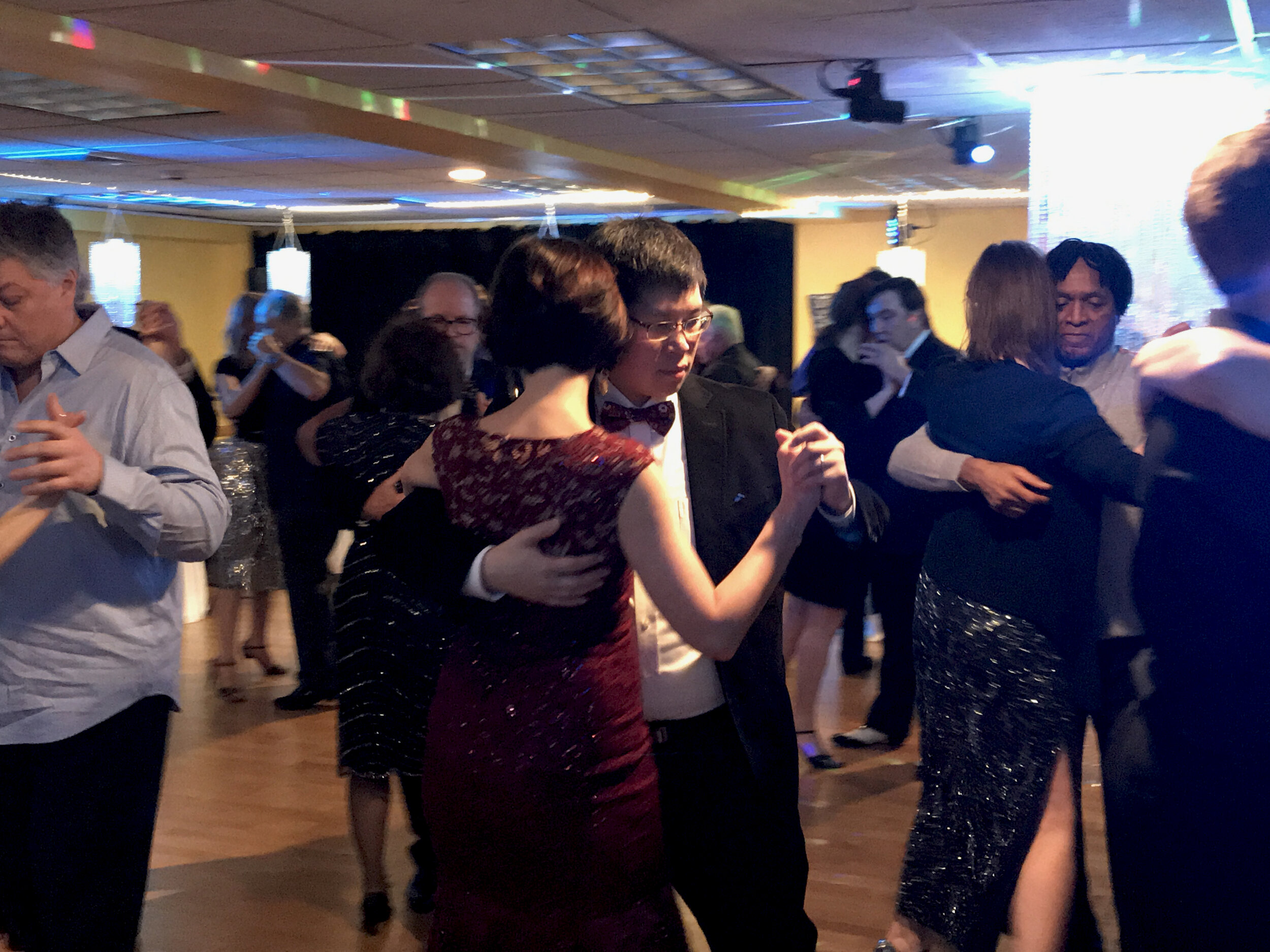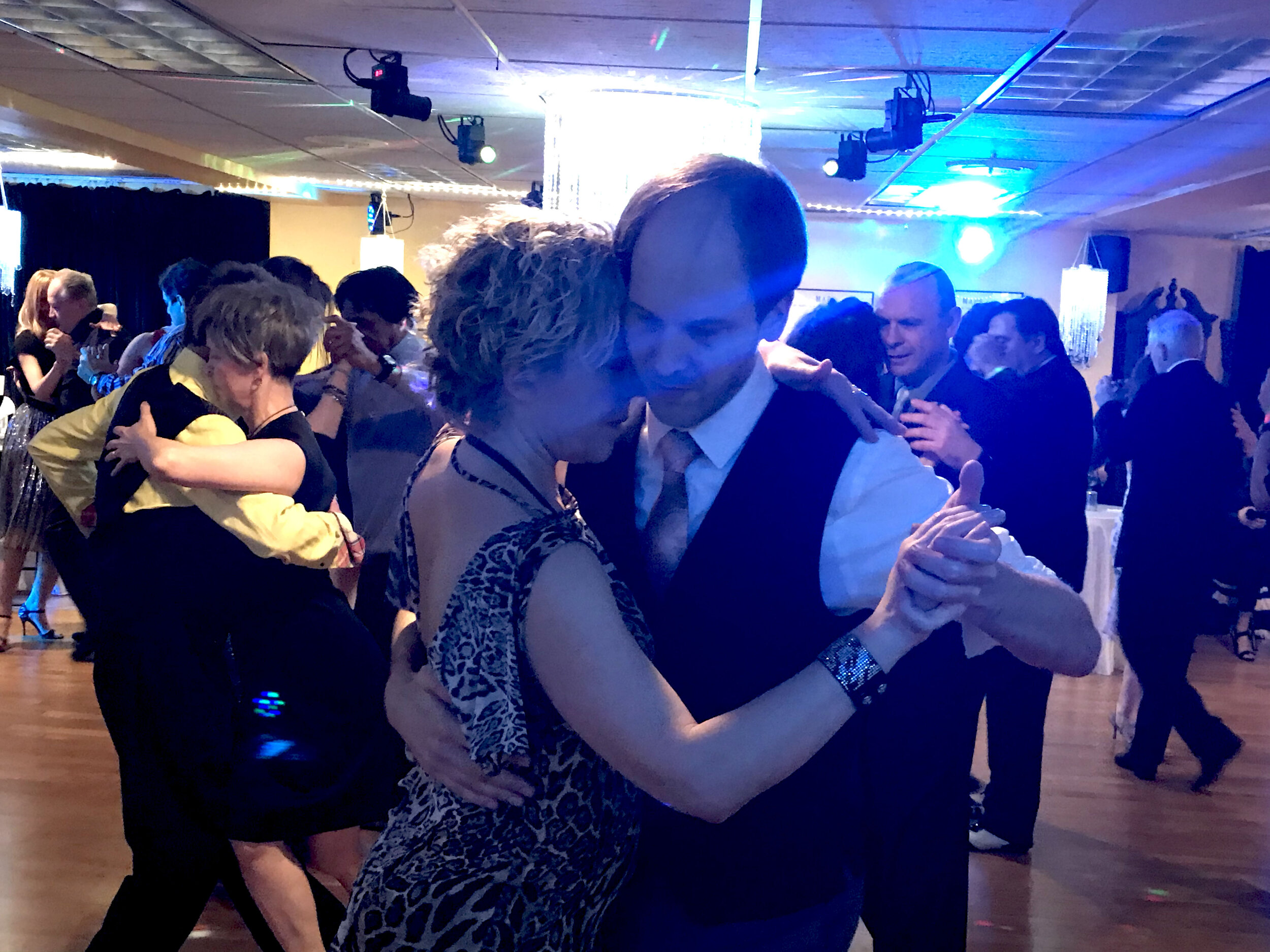Tangasm - Have You Had One?
QUICK WARNING: IF TALKING ABOUT TANGO AND SEX MAKES YOU CRINGE, YOU MAY WANT TO SKIP THIS POST.
Passion, sensuality, connection — all these words are often used to describe Argentine tango. For many tangueros and tangueras, regardless of their level of expertise, tango is regarded as more than just a dance — it is a relationship not just with our partner but with our bodies, emotions, and spirit.
Beyond the techniques and the technicalities of its figures and steps, tango is viewed as a transcendent experience often equated with sex, elevating it from other partner dances that merely provide routines. However, sex can be, in many ways, devoid of the deeper internal and external connection we can achieve from dancing the Argentine tango.
Milonga at Ultimate Tango School of Dance
Perhaps, it is the very nature of tango as an improvisational dance that fosters this idea that it is a sensual — even sexual — experience. The freedom with which we can move while dancing the tango is the kind of liberation that is absent in the daily lives of many people, especially to those whose careers demand intense compartmentalization of time and activities.
As many teachers and dancers have attested, tango is predominantly about feeling the moment, where letting loose, gaining control, and expressing ourselves through our partner manifests into the dance — a dance from which beauty and elegance cannot spring forth when we focus merely on steps and expectations instead of spontaneity.
Thus, unlike other partner dances, Argentine tango has a phenomenon called the “tangasm” — but is this a true experience or one that is merely imagined?
Tangasm: Fact or Fable?
Often purported as myth, the phenomenon that is the tangasm may take on different explanations from different people. Some might regard it as fact, while others see it as fiction.
In Tangasm and more: Interview with Mikhaila Stettler we can hear form the author of Pink Diamonds, who defined the tangasm in her novel: “A tangasm, I come to find out, is an event as rare as a unicorn sighting.”
But one thing is for sure to those who have had the pleasure of experiencing a tangasm: it isn’t an orgasm as many people would easily assume — or at least, not one’s typical idea of what an orgasm is.
In journal PSYCHOLOGY TODAY, Igor Sitchuk provides a psychologically-inclined explanation: “[Tangasm is] not an orgasm that you get by dancing a particularly passionate type of Argentine tango. On the contrary! Sexual tension can actually cause disharmony on the dance floor. A tangasm is, however, absolutely comparable to an orgasm in terms of the pleasure it produces.”
The post further elaborates that
A tangasm is based on sexual energy despite it being a purely psychological phenomenon.
Unlike an orgasm experienced from the physical act of sex itself, a tangasm does not involve erections, as “that would definitely ruin the entire dance — embarrassing for the man and frustrating for the woman.” While an orgasm and tangasm might feel similar, the latter lasts much longer and doesn’t leave behind a “feeling of sexual discontentment.”
Milonga at Ultimate Tango School of Dance. One of the Tango strongest characteristics is relationship building.
On the other hand, an article by Sasha Cagen on huffpost.com defines the tangasm from her perspective and the perspective of other dancers, further elaborating on the feeling it brings about: “A tangasm is not a climax in the way we think of an ‘orgasm.’ There is no particular moment of release. The tangasm is not about how it looks, it’s about how it feels.
A tangasm is a moment of total connection coupled with full-body pleasure, bodies swirling with each other, breathing together, a union with the moment, your partner, the music, the room.
I have asked people about their tangasms and they tell me things like: ‘Losing all notion of time and space.’ ‘You forget about everything and everyone.’ ‘A peak experience.’ ‘Traveling to another galaxy.’ ‘Thoughts floating away.’ ‘Being in flow.’ ‘Embracing and breathing together.’ ‘Dancing on a pink cloud.’ ‘A spiritual practice.’ This doesn’t mean you are sexually attracted to your partner, though you might be. You could feel a tangasm with someone of your same sex if you are heterosexual or even with your parent.”
What else shall we change to make this MIlonga better - our prime designer and daughter Aurelia - while designing the look of New Year Eve Milonga at Ultimate Tango School of Dance
The pressure of bringing one’s partner to release, the post further explains, is absent in a tangasm specifically because the notion of climax does not exist. “The tangasm is based on connection and sensuality rather than climax. This is something I think we can all benefit from in our sex lives, too. Climax can be awesome and deep, but being focused on a goal can cheapen the ride; when there is pressure about getting somewhere, there’s less enjoyment along the way.”
Intimacy without sexual pressure and tension can perhaps be the simplest explanation for a tangasm. It is sex without the sex — at least its physical side.
Going back to the interview with Stettler from toreadornottoread.net, she elaborates on the tangasm on a more personal level:
“Once I got enough technique under my belt that I could follow a basic lead, I began to experience the true gifts of tango: heightened awareness in the present moment, intimate connection with a partner, moment-by-moment improvisation, and attunement to the music. At its best, tango puts me in a state of total immersion, connection, expression and mindfulness — like a highly creative, moving meditation.”
Tongue-Tied With Tangasm
In her huffpost.com article, Cagen speaks to a friend about the tangasm, which the latter, she explains, seems to have misconstrued. This particular friend, Cagen relates, looked up “sexy tango” and understood the tangasm to mean explicit sexual caresses, which was not the case in social tango as opposed to show tango: “‘Social tango’ is much more about the internal experience of sensuality generated through the embrace. In other words, if you go out to a Buenos Aires milonga to watch social tango, you will not see the explicit sexual caresses, but you will see the bliss in the little upturned smiles of the women dancing with their eyes closed and in the focus of the men.”
Milonga at Ultimate Tango School of Dance
What is perhaps difficult in explaining exactly what a tangasm is lies in the fact that such a transcendent experience often leaves us bereft of words that can do justice to the experience itself. A post from Tango Chamuyo articulates this best:
“I can’t begin to define it because words are inadequate. Even if I tried, I wouldn’t convey all the feelings in the moment. It’s not something to think about or to anticipate. You never know when it will happen. When one surrenders to being in the moment, one is prepared in body and soul.”
Similarly, a post from Cagen’s own blog, Three Tangasms, notes having the same feeling of inarticulateness. In this article, Cagen invites three Argentine tango dancers to describe their first tangasm and Virginia Vasconi, one of the dancers invited to talk about the experience, relates:
“It is so hard to describe in words: the most valuable tango treasure: the magical and mysterious connection, the melting in a wonderful embrace that makes you travel to another galaxy! I wish you can all have it at least once!”
A post from Ben Lovejoy "My first tangasm" talks about a similar experience from the perspective of a male leader still learning the ropes of Argentine tango: “Experienced tango dancers often say tangasms are unpredictable things, and I’m absolutely sure there’s a strong element of that.
Why did the ronda seem to be moving tonight when it often seems stuck? How did I manage to have fantastic tandas with three different followers when I’d have been delighted to have had just one of those? Why did I have enough attention to freely incorporate pretty much everything I can lead with what might, on a dark and foggy night, pass for competence? Some things just happen.”
Milonga at Ultimate Tango School of Dance
Tango vs. Sex: Which One Is Better?
With all these descriptions of what a tangasm is, can tango be actually better than sex? Cagen’s entry on huffpost.com attempts to seek an answer by outlining the differences between these two experiences: “With tango, not only do I feel pleasure all over my body, I don’t have to worry about condoms, pap smears, safe sex tests. I’m not going to have an unwanted pregnancy.”
“Looking for hugs in each new partner, I get to “try” many different, new, exciting sensual partners in one night with no negative consequences. In tango, we dance tandas (four songs with one person). “
“Each tanda is like a one-night stand. At the end of the fourth song we say goodbye and thank you, and if I am in Buenos Aires, the man might tell me that I am wonderful, beautiful, divine as he escorts me back to my seat.”
Likewise, in The thrill of dance... Igor Sitchuk elaborates on the fears associated with sex, and why these don’t exist in tango though both may offer a similar experience of pleasure: “There are also several fears associated with sex: inexperience, vulnerability, disappointment, loss of personal freedom and others.
“Tango isn’t sex and that's why none of these problems matter. Dancing is polite (no one will judge you for having a tangasm with three partners during one evening). Dancing is safe and you don’t have to dance with someone who doesn’t appeal to you. No one will drag you to the dance floor against your will. But all the while, you’re enriching your life, are getting rid of depression, are staying fit and feel needed by other people.”
However, only Cagen’s article on huffpost.com seems to tackle the question head on from a personal perspective: “Is tango always better than sex? No. Four years later after the first tangasm, I have a boyfriend who does not dance tango, and I find myself staying home with him often rather than going out to dance. Tango is not always better than sex. It depends on the partner, the connection. On the other hand, I am still going away to Buenos Aires for three months and leaving him to dance tango at the source because the true tango embrace is that powerful. I need my dose.”
Hernan and Anita - Instructors at Ultimate Tango School of Dance
What the post from Sensual & Intuitive Tango does, though, is to pose another relevant question: “Can one be certain that his partner is experiencing a tangasm?”
An affirmative answer may be difficult to arrive upon. “There is no way to answer this question with a yes. A tangasm has no physiological manifestations since it is hidden deeply in the human psyche. Music, contact with your partner, feeling at one with the other dancers around you, the entire atmosphere of the milonga, all of these elements help release the needed images and feelings from the subconscious so that during a tanda (a group of three or four similar dances that a pair dances together)
we’re meeting the prototype of our ideal self and our ideal partner, and an actual ‘love story in 10 minutes’ plays out. Each partner acts as a catalyst in this psychological process.”
As for us, the individual, when can we say that we’ve experienced a tangasm?
An Incomparable Experience
A line from benlovejoy.blog is perhaps the simplest yet most profound way of knowing whether we’ve experienced a tangasm: “[...] tonight was dance. Not even felt like dance; it was dance.”
Is tangasm then magical? From the anecdotes above and many others, it seems like it is. Is it as rare a phenomenon as it is touted to be? It can be for some. Just as an orgasm is a highly personal experience that varies from one instance to the next, each tangasm remains unique and incomparable — no two are alike.
Should we give up one for the other?
Cagen, in huffpost.com, voices what may be our selfish answer:
“One does not want to live in a universe where you have to give up either tango or sex.”









